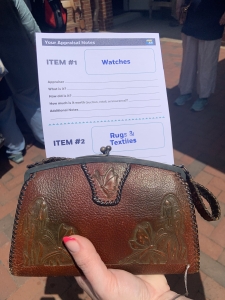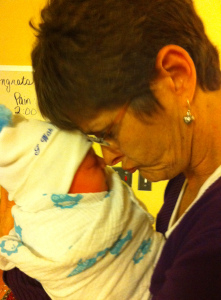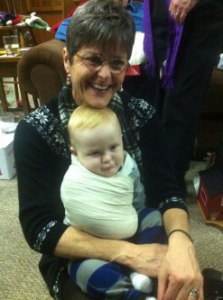Fame was so close to my grasp. I could smell it. I could taste it.
Nah, not that kind of fame. You’ll never catch me dancing on TikTok or “influencing” millions with culinary wizardry or cat videos.
My shot at glory seemed much closer to my grasp, and certainly more age-appropriate.
I longed to be on Antiques Roadshow. The PBS TV series that for 25 years has revealed the history and occasionally breathtaking value of unexpected treasures for collectors across America was coming to Nashville, and I got tickets. From there to stardom seemed what Bertie Wooster would have called a stone-dead cert, if ever there was one.
Why so certain? For starters, my home is stuffed to the proverbial gills with old things. Most of them flowed down from previous generations of our family like a flooded creek running downhill in early spring. Nearly every time a cherished branch of our tree ascended unto heaven, a few meaningful treasures flowed my way. My long-time interior designer once described my decorating style as “inherited”. I love having and using things that belonged to people I adored. Surely it was just a matter of looking around the house with a keen eye, selecting the right item to stun the appraisers and make me famous.
And wouldn’t Karma dictate that Super Fan status counts for something? Across those 25 years of airtime, I doubt I’ve missed a single episode of the Roadshow, gasping in solidarity with the shocked owner of the priceless painting that had been gathering dust in his basement, and so many others. I can re-tell in explicit detail the incident of the long-haired, headband-wearing veteran who literally dropped to the ground in shock—drawing a concerned show staffer hurriedly to his side—when told his Rolex watch, purchased on a sparse military salary four decades earlier, was worth $700,000.
Why not me? As show taping day approached, the item selection process rose to a crazed pitch. Each ticket holder is allowed to bring only two items, and I paced the house and pondered the available choices. My daughter kindly and patiently agreed to come along on the second ticket. We ultimately agreed that portability was key, given the location and transport options. We settled on small, intriguing items: a tiny rose-gold ladies watch framed by two large, brilliant amber citrines; a finely tooled, tiny leather handbag belonging to my great-grandmother, its original lining and tiny, attached mirror still intact; and two exotic, hand-painted porcelain plates of my grandmother’s. Then there was the piece de resistance: A stunning diamond ring belonging to yet another great-grandmother, set with two enormous, flashing center stones flanked by a dozen smaller ones. I had recently inherited this piece and longed to know more about its age, maybe even the designer and any details on the style and era it represents.
When you can smell and taste that big moment ahead, proper preparation is key. We chose attire carefully—colorful, but not too bright, stylish but comfortable. As to whether I actually rehearsed my eye-popping shock at the anticipated appraiser’s news, well, I say nothing.
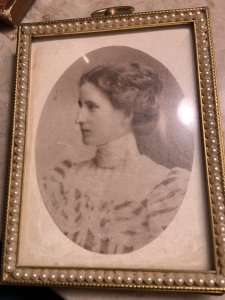
My great-grandmother, Lavinia Sipp Kelley.
Regular viewers know that provenance is everything. Searching stored boxes of framed family likenesses (admittedly, we are rather heavy on those, too, and a house only has so many walls), I unearthed Great Grandmother’s tiny, framed portrait. I had relegated her to storage decades before, intimidated by the image of her rather stern countenance. Re-examining the study of her young face, now a grandmother myself, I was stunned to realize how lovely she was. I added to my bag a printed copy of the page in the family bible bearing her name, dates of birth, marriage and death. Now, we were ready.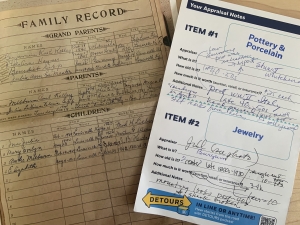
The Roadshow, staged in Nashville with support of WNPT, our local PBS affiliate, is a remarkably well-oiled production. Lines were short, but I prolonged our progress by gawking at my longtime TV heroes as we passed them. I’ve been watching so long I’ve seen several turn from brunettes to sporting gray hair. Look! I told my daughter. I can’t think of his name, but there’s the poster guy with the loud plaid pants! And I nearly bumped elbows with another favorite, the New York-talking jewelry expert Kevin Zavian, as a producer hustled him toward one of the several camera booths spread across the property. Could the lovely old ring land me in that booth with Kevin later? I inhaled a sharp, quick breath for a nano-second of anticipation.
Alas, it was not to be. Kevin was nowhere around as we approached the jewelry table. The smiling appraiser we met studied the ring through her loop, complimented it lavishly, identifying the largest stones as cut somewhere between 1890 and the 1930s, consistent with our family history. She speculated that the mounting was newer by a couple of decades, a puzzle given the family tale. Of the style or location of origin, she was unable to speculate. “That’s gorgeous,” she said, handing it back while delivering an auction estimate considerably below the recent estate appraisal. “I’d sure wear it and enjoy it.” Oh, I will! I answered brightly. I may have looked out of the corner of one eye to see if any cameras were watching from a distance, or maybe I didn’t; it’s hard to say.
Could we land on TV with a low-value but interesting item? There were three more chances. Over at the china and porcelain table, the handsome, smiling gentleman examined my grandmother’s plate and delivered immediate specifics. 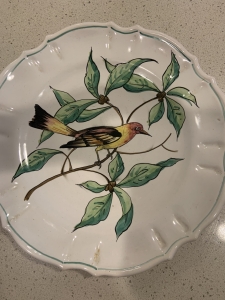 “These are Italian, hand-painted,” he began. “They are very nicely glazed. A huge number of Italian ceramics came into this country immediately after World War II, as that industry survived the war in Italy. I would date them between 1945 and the early 50s, and they are as common as raindrops in April. Probably worth $25 each.” For the plates, my interest in origin and age was greater than any expectation of value, so this information gained him a wide smile in return. (Of course, raindrops in April also don’t earn the eye of the camera.)
“These are Italian, hand-painted,” he began. “They are very nicely glazed. A huge number of Italian ceramics came into this country immediately after World War II, as that industry survived the war in Italy. I would date them between 1945 and the early 50s, and they are as common as raindrops in April. Probably worth $25 each.” For the plates, my interest in origin and age was greater than any expectation of value, so this information gained him a wide smile in return. (Of course, raindrops in April also don’t earn the eye of the camera.)
Still, it was big fun to hear the appraisers react to our items. Over at the couture table, appraiser Kathleen Guzman was intrigued by our tiny leather handbag, which my other had handed down to my daughter years ago. “This is beautiful and in great condition,” she said. “I had never seen one of these before, and this is the second one I’ve seen today.” Finally, appraiser Jeff Cohen at the watch table examined the tiny rose gold specimen and delivered our surprise of the day. “1940s,” he said. “Swiss movement, though I’m not sure  the maker. The citrines are what make this one very desirable. I’d put it in an auction with a pre-sale estimate of $2,000-$3,000.” Wow! Score one on the upside.
the maker. The citrines are what make this one very desirable. I’d put it in an auction with a pre-sale estimate of $2,000-$3,000.” Wow! Score one on the upside.
And that was that. We lingered a few minutes watching the cameras record an appraiser discussing a modernist painting, then moved to the line for the bus. Unable to avoid the potential regret of revisiting our item selections, my daughter and I felt immediate kinship with a friendly attendee in line behind us. I asked her if she learned anything interesting about her item. “Yep,” she grimaced. “I learned I should have brought something else.”
One final chance for TV stardom emerged as we moved forward in the bus line. The feedback booth, open to any volunteers, languished without many participants on that hot afternoon. Faithful viewers know it as short clips of attendees commenting about their experience at the end of the show.
Let’s do it! I nudged my daughter. Think how your kids would love to see us on TV! We finger-checked our hair, applied lipstick, and stepped before the spotlight. I shared my “common as raindrops in April” story, and she held up the precious little handbag for the camera. It’s doubtful we were funny or unusual enough to make the edited show, but we’ll know when it comes out in about six months.
A disappointing day? Most certainly not. We saw famous people, learned interesting things, and I got a rare chance for a day with my daughter, just the two of us. We went out afterward for Japanese food and plum wine and a great chat about the day.
After all, isn’t it the rich anticipation of the ultimate outcome that makes the experience so alluring? That’s what draws the player back to the poker table and the punter back to the betting window. From the dusty shelves of thrift stores or the dark recesses of grandparents’ closets to the bright light of the camera and unimagined riches is but a step. Others grabbed the spotlight this time, but in the future, it could always be us. I can feel it.

